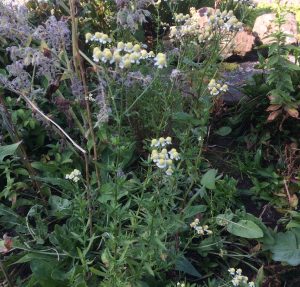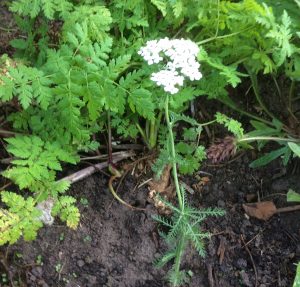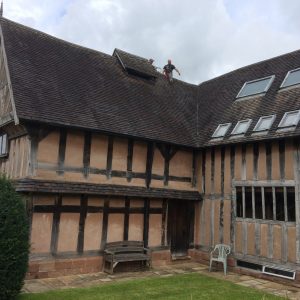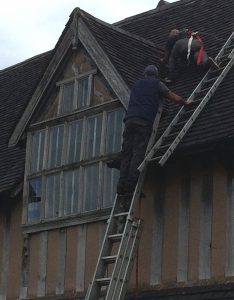There were no official visitors on the site, during August, but once lockdown restrictions were eased, a few personal friends, who were in the same high risk category as Griselda and Alan Garner, came into the garden. Among them was Barbara Depledge, who is in charge of the herb garden project that aims to replace the current herbs with those of the species recorded in John Gerrard’s ‘Herball, or Generall Historie of Plantes, first published in 1597.
The day before she came, Griselda noticed that a small feathery leaved plant, with white blossoms, had invaded the grass behind the Old Medicine House. Barbara and Griselda identified it as yarrow. There’s yarrow in the herb bed, but it is taller, the leaves are less feathery and the flowers are bigger.

It’s possible that the yarrow in the herb bed is a modern hybrid and the yarrow in the grass is the native yarrow found in meadows and on banks. If that is the case, it’s possibly closer to Gerard’s yarrow, and the plant that should be in our herb beds. Griselda extracted several plants from the grass and planted them in one of the herb beds. Like the plants that arrived with the Old Medicine House in 1972, they are thriving.

For many months there have been several attempts to find a roofer to replace broken tiles and reset ones that have slipped on the roof of the Old Medicine House. Several roofers have come to assess the job. All have said that to put ladders onto a roof of handmade tiles risked breaking more than needed repairing. Finally, we struck lucky and two roofers arrived. They stood around, looking at the house and talking. Then they put their ladders against the roof, tackled themselves up with safety harnesses and ropes, and within minutes, they were up on the roof scaling it as if it were a mountain. It was beautiful to watch.

All the tiles were swiftly replaced; none were broken.
When Griselda asked how they managed to do it, one of them said, ‘You have to spread the load like a spider and it helps to be light.’

